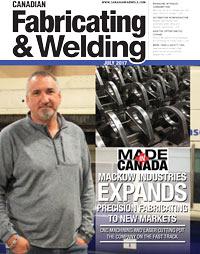Contributing Editor
- FMA
- The Fabricator
- FABTECH
- Canadian Metalworking
More than a safety tool
How one electric brake’s light guard can act as a production support tool
- By Dan Davis
- July 26, 2017
- Article
- Fabricating

The light guard that is integrated into the SafanDarley E-brake provides safety and can be used to improve bending times. Photo courtesy of Westway Machinery and SafanDarley.
In most instances, light guarding on a press brake is associated with a simple safety function. If the light curtain sensors on either side of the bending window pick up anything other than the metal to be bent, the safety system shuts the machine down. The operator or interloper, whatever the case may be, is safe, but the bending process is stopped.
The light guard for the SafanDarley E-Brake, which is integrated into the press brake, provides the same safety function, but it also can be used to improve bending cycle times.
“Most people don’t want to invest in safety because they think it slows down productivity,” said Mauricio Gutierrez Matta, SafanDarley’s area export manager. “That’s why we invented something that would improve productivity and improve safety at the same time.”
The press brake has been engineered so that the operator can use the light guard as a means to direct operation of the ram. Different modes allow the operator to use the foot pedal or interruption of the light curtain or a combination of the two to run the machine. This can be a real benefit. “Sometimes hanging on one foot for eight hours a day while you are trying to press a foot pedal with the other foot can grow tiresome,” said Nick Millard, manufacturing manager at Alaso, a poultry equipment manufacturer in Lakeland, Fla.
For example, the machine’s “one break” mode can be set up for a rapid bending job. The operator’s simple interruption of the focus area in the bending tooling can trigger the ram to advance at 10 mm per second to produce the bend; the operator can then remove the bent part, put another blank in its place (which triggers the ram to advance), and continue the process. This type of option also is helpful when an operator is struggling with a large or awkward-shaped part and is unable to reach the foot pedal.
In many of the modes, the press brake is intelligent enough to advance to just millimeters above the actual pinch point to accelerate the bending process. Typically, a press brake needs a couple of seconds to cycle from the top of the bending window to the actual bend for every step in a bending job. If the ram is situated to allow just enough room for a flat part to be inserted, the press brake does not require several seconds to complete the forming action. When the operator has to extract the bent part, the press brake knows that the ram has to fully rise to accommodate the removal of the part.
The light curtain is able to keep tabs on the bending area while also allowing other movement in the press brake window because the sensors focus on an area of about 30 mm, or a little over 1 inch, where the bending takes place.
These different modes are hard-wired into the machine. Any adjustment requires the operator to have a key and to walk to the side of the machine to select the appropriate bending mode.
If a mistake is made and the light guard senses a presence that it shouldn’t, the ram stops within 80 milliseconds. The servomotors controlling the ram movement can stop it much more precisely than a hydraulic system.
As one user commented, the machine really shines with larger job runs, where the operators are able to take advantage of this technology and eliminate wasted press brake motion commonly associated with older press brakes, which have rams that have to retreat to the top of the operational window before they can cycle down for another hit.
Editor-in-Chief Dan Davis can be reached at dand@thefabricator.com.
Alaso, 863-606-0033, www.alaso.com
SafanDarley, www.safandarley.com
Westway Machinery Ltd., 800-263-1199, www.westwaymachinery.comAbout the Author
subscribe now


Keep up to date with the latest news, events, and technology for all things metal from our pair of monthly magazines written specifically for Canadian manufacturers!
Start Your Free Subscription- Industry Events
MME Saskatoon
- May 28, 2024
- Saskatoon, SK Canada
CME's Health & Safety Symposium for Manufacturers
- May 29, 2024
- Mississauga, ON Canada
DiPaolo Machine Tools Open House 2024
- June 4 - 5, 2024
- Mississauga, ON Canada
FABTECH Canada
- June 11 - 13, 2024
- Toronto, ON Canada
Zoller Open House & Technology Days 2024
- June 12 - 13, 2024
- Ann Arbor, MI




















